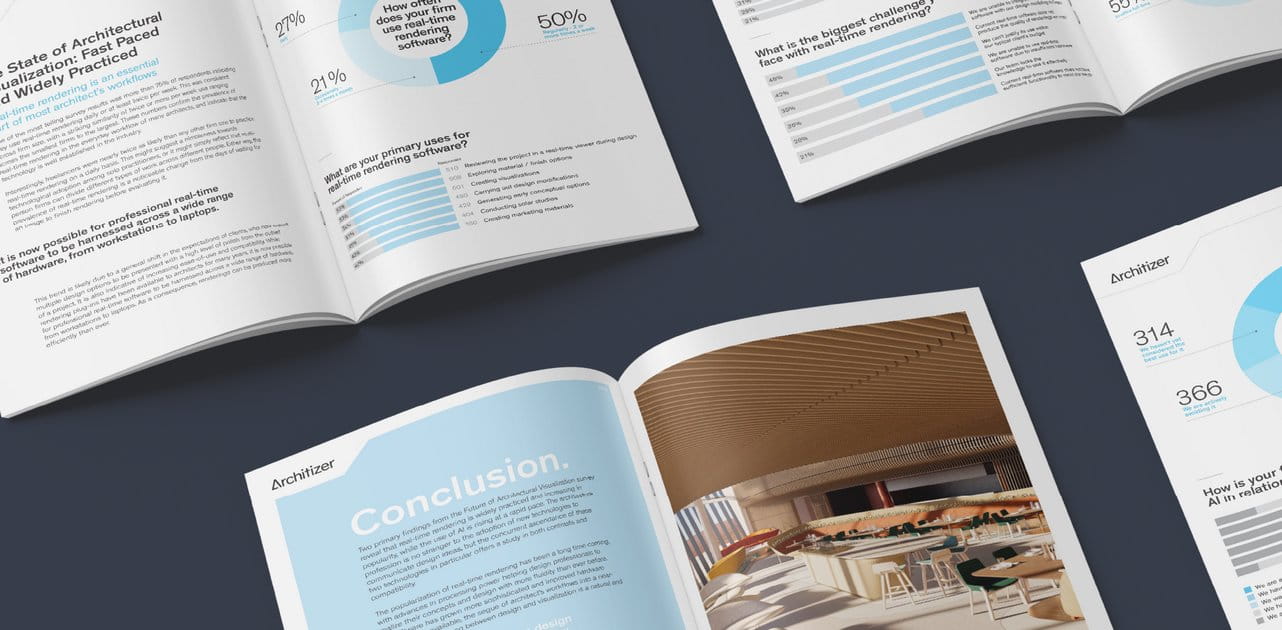As technology advances, clients are expecting more from architects and designers, which leads to heavier workloads. Design professionals are reinventing their workflows, so that design processes are more dynamic. A polished effect - achieved during an over the shoulder review - is now a realised dream for many.
46% of respondents cited that real-time rendering allows them to save time and speed up the design process 1 in 2 respondents report that real-time rendering software will be used to review the project in a real-time viewer during design
When asked about the main uses for real-time rendering software, respondents indicated that this new approach is helping design professionals to handle client hesitations and speed up the client decision-making process:
- Quickly applying and reviewing different material options (54.3%)
- Walking through a model with clients or collaborators (50.1%)
- Reviewing daylighting instantly in 3D (47.9%)
Architectural visualisation happens in-house
The preference for architectural visualisation to happen in-house, including real-time rendering, highlights a new requirement for architects to have an understanding of visualisation techniques. This marks a shift towards greater autonomy and expertise within firms, regardless of size.
- 43% of firms have one or more dedicated in-house visualisation experts
- 32% of firms have their architects or designers produce their own visualisations
Freelancers or small companies (1-5 employees) are more likely than large firms to have designers create their own visualisations
Greater technical innovation is needed to keep up with demand
As client demands are increasing, in turn firms are expecting superior performance and functionality from their visualisation software. Many firms still face technical challenges and frustrating limitations with their chosen software. The biggest challenges with real-time rendering cited were:
- We are unable to integrate real-time software with our design modelling software (48%)
- Current real-time software does not produce the quality of renderings we need (42%)
- Current real-time software does not have sufficient functionality to meet our needs (21%)
More than half of firms are already using AI for architectural visualisations
Designers are also exploring the potential of AI to improve their visualisation and overcome rendering challenges. Larger firms are embracing AI quicker than smaller firms, but firms of all sizes are planning for future AI investment.
- 55% of design professionals are already using AI in relation to architectural visualisation
- 19% indicated they utilise AI to create AI-assisted or AI-generated visualisations
- 2 in 5 design professionals see AI as an area for investment over the next year
Design is an early adopter industry in a new technological revolution
Roderick Bates, Director, Corporate Development at Chaos says: “The Future of Architectural Visualisation report highlights how open the architecture profession is to adopting new technologies. The popularity of real-time rendering has been a long time coming - advances in processing power have made real-time the default, allowing architects to create designs while simultaneously and fluidly generating sophisticated visualisations.
While the adoption of real-time rendering has been steady, it is now to the point where it is ‘table stakes’ for many architects. We are now seeing AI as the next technology frontier, and it is being integrated at speed - design professionals are clearly not shying away from AI technology.
We are one of the best stores with 3D models - do you want to check what high-quality 3D models we offer?
Customer zone
Your special offers
Your orders
Edit account
Add project
Liked projects
View your artist profile























COMMENTS